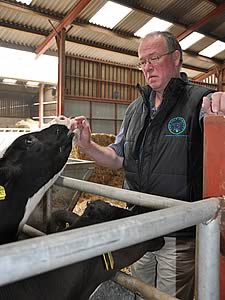 |
|||||||||
|
|||||||||||||||||||
|
|
Calf Trial Highlights Benefits of Once-a-Day Milk Feeding A new Harper Adams University College trial has shown that beef calves on the right once-a-day milk feeding regime will grow faster and can be weaned earlier compared with pen mates on a twice-a-day system.
“In our study the calves fed once-a-day recorded significantly higher daily liveweight gains from start to three weeks. They were also weaned 1.9 days earlier having gained an extra 3.6kg in liveweight,” reports trial project co-ordinator Simon Marsh, senior lecturer and beef specialist from Harper Adams. The independent feeding trial, commissioned by Bonanza Calf Nutrition, examined the rearing performance of 40 purchased Holstein and Continental cross Holstein bull calves. They were, on average, 20.5 days old at the start of the trial and were split into two groups. The calves were individually penned and bucket fed 600g of milk replacer either once or twice a day. The Once-a-Day calves were fed a skim-based milk replacer containing whey and butter oil (Shine Once-a-Day), mixed at 200g per 800ml of water and fed at the rate of three litres per day. The Twice-a-Day calves were fed a whey-based milk replacer containing skim and butter oil (Shine Flying Start) mixed at 120g per 880ml of water and fed at the rate of 2.5 litres, twice per day. The calves were also offered ad lib early weaning concentrates, with their performance monitored to 12 weeks of age. “Overall the performance of both groups of calves was very good, exceeding the recognised target for rearing calves to 12 weeks of 115kg (see table 1),” Simon Marsh says. “But the Once-a-Day calves did do that little bit better. And, interestingly, the contentment of the calves fed once-a-day was also noticeable. They drank their three litres in a single feed then rested and weren’t at all hungry later in the day. They were also free from nutritional scours, unlike some of the twice-a-day fed calves, and had increased rumen girth measurements; an indication of improved rumen development, potentially because of their higher (11.5kg) concentrate intake.” Feed costs per calf were increased by £4.35 on the once-a-day system, but the feed cost per kg of liveweight gain was actually 4.7p lower based on costs prevailing at the time of the study. “In any case, the saving in labour charges – estimated at around £10 per calf in a study we conducted in 2007 – would negate the increase in overall calf feeding costs,” Simon Marsh notes. Simon Marsh says the results will be interesting for calf rearers, offering many food for thought as they contemplate a variety of business challenges. “As producers seek to benefit from economies of scale, stockmen are coming under more and more pressure to look after increasing stock numbers. Consequently, the development of lower labour-input systems is vital. The introduction of a once-a day milk feeding system for three-week-old calves – that clearly does not affect performance or health; indeed may improve both parameters – is one such opportunity. “Provided you use the right skim-based milk replacer product, calf health and performance is excellent with the added bonus that the system releases time for other important stockmanship tasks such as the early identification of disease,” he says. Table 1: Calf Performance
|
||||||||||||||||||

|
|
||||||||||||||||||
| home | agri-services | pedigree
pen | news | dairy | beef | machinery BPS | property | organisations | site map |
|||||||||||||||||||



